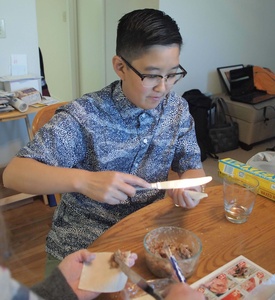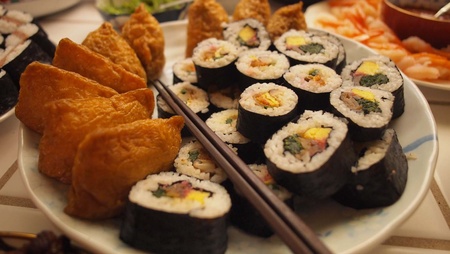If Japanese Americans have a Norman Rockwell holiday, oshogatsu is it.
Instead of someone serving turkey to a long table of guests, the Nikkei version would likely feature people passing osechi ryori boxes and cups of sake. It’s a time to gather with family and friends, stuff our faces with food, drink, relax, and play games. It’s a holiday that evokes warmth, joy, and home.
But is a Norman Rockwell holiday something to want to emulate? After the 2020 uprisings demanding racial justice for Black Americans and the ongoing marches raising awareness about the thousands of missing and murdered Indigenous women, girls, and two-spirit people, it’s an impulse I question with increased curiosity.
As we observe another oshogatsu celebration, I find myself tracing my understanding of race, racism, and belonging through my relationship with the holiday.
When I was younger, I used to hate oshogatsu.
As a child, oshogatsu felt uncomfortable. The non-Nikkei people I knew only celebrated New Year’s Eve. My family’s ritual of going to the temple on New Year’s Eve to ring a kansho bell and in the morning after eating more toshi koshi soba, before embarking on a pilgrimage to different temple members’ homes felt so foreign. It was one more thing that set me apart from the American (read White) teachers and peers I desperately tried to emulate and impress.
At the first house, I’d eat jello squares. Since we’d just eaten, I’d sulk on the couch while playing on my handheld gaming device at the second house. The third family we visited had delicious chicken wings. At the fourth house, I’d eat kamaboko slices and char siu. And at the last home, I’d eat mini cherry cheesecake bites. For the most part, I did my best to avoid eating anything that smelled weird, anything made from root vegetables, and anything featuring raw seafood. In short, I tried not to eat anything that seemed too Japanese. (I couldn’t resist eating the kamaboko, though. It was the only time of year I saw the slices come in so many different colors, and kamaboko was my favorite food!)
It wasn’t until my Nikkei friend who went to the same public school as I asked what I was doing for oshogatsu that year that I realized 1) this was a Nikkei holiday that had a name and was not just a weird thing that immigrant Buddhists did and 2) that some people look forward to it. Unlike myself, my Nikkei friend was, in my opinion, beloved amongst our peers. And her popularity gave me newfound permission to acknowledge not just oshogatsu but many parts of myself that I disliked. I still wasn’t shouting from the rooftops that my family observed this tradition, but I wasn’t actively hiding it anymore either. I began to feel excited about attending Joya-e service. I started to anticipate eating my uncle’s fried wonton contribution to our celebrations. It wasn’t Japanese food, but it was a start.
My relationship with oshogatsu changed again shortly after college. Having attended a school that measured diversity in six shades of blonde, I found kinship amongst other Asian Americans and immigrants of color. I started to see how foreign didn’t have to be a source of shame. It could be a source of pride. Having something that set me apart now became a way to belong. I started to become more curious about Japanese and Nikkei culture. I learned who Utada Hikaru was and sang “First Love” during our oshogatsu karaoke time with my two siblings. My dad was impressed.
And then the year came that I began participating in more than just eating on oshogatsu. It was the year my grandmother taught my spouse and me how she made makizushi rolls. By this time, my family had stopped visiting temple members’ homes for oshogatsu, and we had begun hosting gatherings at our house. My grandparents and several other family members drove from the Central Valley to join us. And because we were expecting more people that year than usual, everyone was expected to help prepare the food. My grandmother taught us to layer the tamago, kanpyo, shrimp powder, mushrooms, spinach, and unagi. And she let us in on her secret to creating a beautiful and uniform presentation—“cut off the messy ends and eat them before anyone sees!” Being let in on her secret felt so endearing, I decided to try makizushi for the first time. I surprised myself with how much I enjoyed it. Now it’s not just a marker of immigrant heritage; it’s something I look forward to making every year, each messy end reminding me of that moment.
Now, a global pandemic and many conversations about White Supremacy culture later, I realize that this oshogatsu presents another opportunity to heal my internalized racism. This year, I’m taking ownership of the holiday. I’m setting intentions for why and how my spouse, child, and I build oshogatsu traditions. I bought my first kagami mochi to display at my home. I am putting together a shopping list for the Japanese grocery store. And I’m learning about the significance of osechi ryori so I can pass those stories on to my kid.
I’m hoping that through repeating the origins of oshogatsu, I can connect my child with one way Nikkei communities have resisted complete assimilation and why that’s vital for self-acceptance and solidarity with others affected by racial discrimination and violence. I’m building economic ties to local Nikkei institutions. And I’m allowing myself the chance to know the culture and community I come from without judgment, a gift for my inner child.
© 2022 Norio Umezu Hall





